Healing from Trauma: Why Your Scars Are Symbols of Strength

When we talk about healing from trauma, many people assume it means forgetting. Pushing away the past. Burying the pain. But true healing doesn’t mean erasing the wounds we carry. It means learning to live with them. It means recognizing our emotional and psychological scars as part of our story — not as flaws to hide, but as reminders of everything we’ve survived. In therapy, this shift in mindset is often where the real transformation begins. What Trauma Really Is — And Why It Stays With Us Trauma doesn’t always come from a single, dramatic event. It can result from prolonged stress, emotional neglect, sudden loss, or even ongoing microaggressions. Whether you’re aware of the moment your trauma began or not, the effects are deeply real and personal. Emotionally, trauma can make us feel unsafe, disconnected, or numb. It can erode our sense of self and leave us hypervigilant, anxious, or depressed. Physically, it often manifests in fatigue, sleep disturbances, muscle tension, and chronic stress symptoms. You might not “see” your trauma the way you see a scar on your skin — but it lingers, often just beneath the surface. Why Healing Doesn’t Mean Forgetting Healing is not a destination where pain disappears. Instead, it’s an ongoing process of making peace with your past, learning to care for your inner world, and integrating your experiences into your life story. Forgetfulness is not strength — presence is. Avoidance may feel protective at first, but in time, it can isolate us from ourselves. The people who learn to sit with discomfort, face the truth of their past, and still choose growth are often the most resilient among us. Your scars — emotional, psychological, or physical — are evidence that you’ve been hurt and that you’ve healed. They are the bridges between survival and strength. Embracing Scars as Evidence of Strength So many people view their emotional wounds as something to be ashamed of. But in reality, scars are proof of healing. They say, “I made it through something hard. I came out the other side.” Shifting your perspective in this way is liberating. Instead of defining yourself by the pain you experienced, you begin to define yourself by the strength it took to endure it. You reframe your past not as a permanent injury, but as a source of power. This doesn’t mean glorifying trauma. It means reclaiming agency — recognizing that even in situations where you had no control, your choice to heal is still yours. Growth After Trauma Is Possible — Even Common It may surprise you to know that research shows many trauma survivors don’t just bounce back — they grow forward. This is called Post-Traumatic Growth (PTG), a concept supported by decades of psychological research. PTG describes the positive psychological changes that can occur as a result of struggling with traumatic experiences. These changes often include a deeper appreciation for life, stronger relationships, increased emotional resilience, spiritual development, and a newfound sense of personal strength. More than half of trauma survivors report experiencing some form of positive growth after adversity. While that doesn’t mean the trauma was “good,” it does show how capable we are of rebuilding something meaningful from our pain. Kintsugi and the Beauty of Imperfection In Japanese culture, there is an art form called Kintsugi, where broken pottery is repaired with gold. Instead of hiding the cracks, artisans fill them with shimmering lacquer, transforming the once-broken object into something more valuable and beautiful than before. The philosophy behind Kintsugi teaches us that our imperfections and scars are not blemishes — they are features of our uniqueness and proof of resilience. This metaphor resonates deeply with trauma survivors. What if your cracks — your wounds, your healing — were not just tolerated, but honored? What if your story, as it is, was already worthy? Across cultures, scars are often seen as symbols of strength and bravery. In some traditions, they mark rites of passage or life-defining courage. Embracing this view can empower you to see yourself not as damaged, but as forged through fire. Your Story Matters: Turning Scars Into Strength One of the most powerful ways to reclaim your trauma is by telling your story. Whether through journaling, speaking with a therapist, creating art, or simply talking with a trusted friend, expressing your journey can be healing in itself. Telling your story does three important things: It validates your experience. Naming what happened — and how it affected you — is a crucial step in moving through pain. It breaks isolation. So many survivors feel alone, but in truth, trauma is incredibly common. Sharing builds connection. It empowers others. When you speak your truth, you give others permission to do the same. Your story may be someone else’s survival guide. This doesn’t mean you have to share everything with everyone. But when you do speak, speak from your strength — not your shame. Therapy: A Safe Space to Heal and Integrate If you’re reading this and realizing you’ve buried pain, or that you’ve never given yourself permission to embrace your scars, therapy can be an invaluable space to begin that journey. In therapy, you’re not expected to have the answers. You’re simply invited to bring your whole self — the broken parts, the strong parts, the confused parts — and be seen. With the support of a therapist, you can begin to: Process difficult memories at your own pace. Reframe self-critical thoughts and internalized shame. Learn grounding techniques to handle anxiety and triggers. Build healthier relationships with yourself and others. Most importantly, therapy provides a relationship built on empathy, trust, and non-judgment. For many people, it becomes the first place where they feel safe enough to begin truly healing. Daily Practices for Embracing Your Scars While therapy can be a cornerstone of healing, there are also daily practices you can incorporate into your life to support your journey: 1. Self-CompassionTalk to yourself with the same kindness you would offer a dear friend. Replace harsh
Beat Stress: Your Brain Is Your BEST Weapon

Stress is the modern epidemic. It creeps into our lives through demanding work schedules, family obligations, financial pressures, and the constant digital noise that never lets us fully unplug. Yet, even though stress may feel like it’s taking over, you already possess the most powerful tool to fight it: your brain. The human brain is not just affected by stress — it’s also uniquely equipped to manage, heal from, and even grow stronger through it. With the right strategies and support, your brain can become your most valuable ally in reducing stress and living a more balanced, fulfilled life. Let’s dive into how stress works, how your brain responds, and what you can do — starting today — to take control. Understanding What Stress Really Does to You At its core, stress is your body’s way of responding to any kind of demand or threat. When you perceive danger — whether it’s a looming deadline or an actual physical threat — your nervous system springs into action. Your heart races, your muscles tense, your senses become sharper, and your brain gets flooded with cortisol and adrenaline. In short bursts, this response is helpful. It can boost your focus, sharpen your reflexes, and help you power through tough moments. But when stress becomes chronic — meaning it sticks around long after the threat is gone — it starts to wear down your mental and physical health. Long-term stress can shrink the hippocampus (the part of your brain responsible for memory and learning), increase the size and sensitivity of the amygdala (which processes fear and emotions), and reduce functioning in the prefrontal cortex (your brain’s control center for decision-making and rational thinking). That’s why chronic stress can leave you feeling foggy, irritable, and emotionally reactive — not to mention physically exhausted. The Brain’s Secret Superpower: Neuroplasticity Here’s the good news: your brain is incredibly adaptable. It’s wired for change. This process, called neuroplasticity, allows your brain to form new connections, strengthen healthy pathways, and even repair damage caused by stress over time. You’ve probably experienced this without realizing it — maybe you learned to stay calm under pressure after years in a high-stakes job, or you noticed how much easier it became to meditate or practice deep breathing the more you stuck with it. That’s your brain reprogramming itself. Even better? You don’t need to overhaul your life overnight. Small, consistent shifts in how you think and behave can trigger powerful transformations in how your brain handles stress. Training Your Brain to Think Differently About Stress Thoughts play a massive role in how we experience stress. The same situation can feel overwhelming or manageable depending on how we interpret it. This is where cognitive strategies come into play — particularly those used in Cognitive Behavioral Therapy (CBT). CBT helps you recognize negative thinking patterns and replace them with more helpful, realistic ones. For instance, if your first reaction to a mistake is “I’m such a failure,” CBT would guide you to challenge that thought: Is that true? Is there another way to see this? What would I say to a friend in this situation? Over time, this practice of re-framing becomes second nature. You stop catastrophizing and start responding from a calmer, more grounded place. Another powerful mental tool is mindfulness — the practice of bringing your full attention to the present moment. Instead of spiraling into “what if” scenarios about the future, mindfulness helps you anchor into what’s happening right now. Studies show that just a few minutes a day of mindfulness meditation can lower cortisol levels, improve emotional regulation, and boost focus. And don’t overlook the value of writing. Journaling helps your brain process experiences, track patterns, and make sense of emotions. It turns the swirling chaos in your head into something tangible you can reflect on and, ultimately, work through. Daily Habits That Build Stress Resilience Let’s shift from the brain to your body — because the two are deeply connected. Your physical habits can either fuel stress or help release it. Exercise is one of the most effective natural stress relievers. You don’t need to run marathons — even a 20-minute walk can calm your nervous system, release endorphins, and improve your mood. What you eat also matters. Diets high in sugar, caffeine, and processed foods can spike anxiety and drain your energy. On the other hand, brain-boosting foods like leafy greens, berries, nuts, and fish rich in omega-3s can stabilize mood and support cognitive function. Then there’s sleep — the ultimate reset button. Without enough restorative rest, your brain struggles to regulate emotions, concentrate, and problem-solve. Create a wind-down routine, limit screens before bed, and aim for 7–9 hours of quality sleep each night. Finally, consider giving your brain some quiet time. We are constantly bombarded by emails, alerts, and social media, which keeps our stress response on high alert. Try unplugging for an hour each day or scheduling regular “digital detox” weekends. Your brain needs space to recharge. When It’s Time to Ask for Help You don’t have to handle stress alone. While self-care strategies are incredibly effective, sometimes the weight of stress becomes too much to carry without guidance. That’s when working with a therapist can make all the difference. Therapy offers a safe, supportive environment to explore the root causes of stress, understand your unique triggers, and develop personalized tools to manage them. Evidence-based approaches like CBT, Mindfulness-Based Stress Reduction (MBSR), and Eye Movement Desensitization and Reprocessing (EMDR) can help rewire the brain’s response to stress and trauma. Not sure if you need therapy? Ask yourself: Are you constantly overwhelmed or anxious, no matter what you try? Is stress interfering with your relationships, work, or health? Do you feel emotionally numb, exhausted, or on edge most of the time? If any of that resonates, therapy may be a wise and healing next step. The key is finding someone who understands what you’re going through and whose approach aligns with your goals. Look for
Understanding Grief: Why It’s Not a Disorder but the Price We Pay for Love
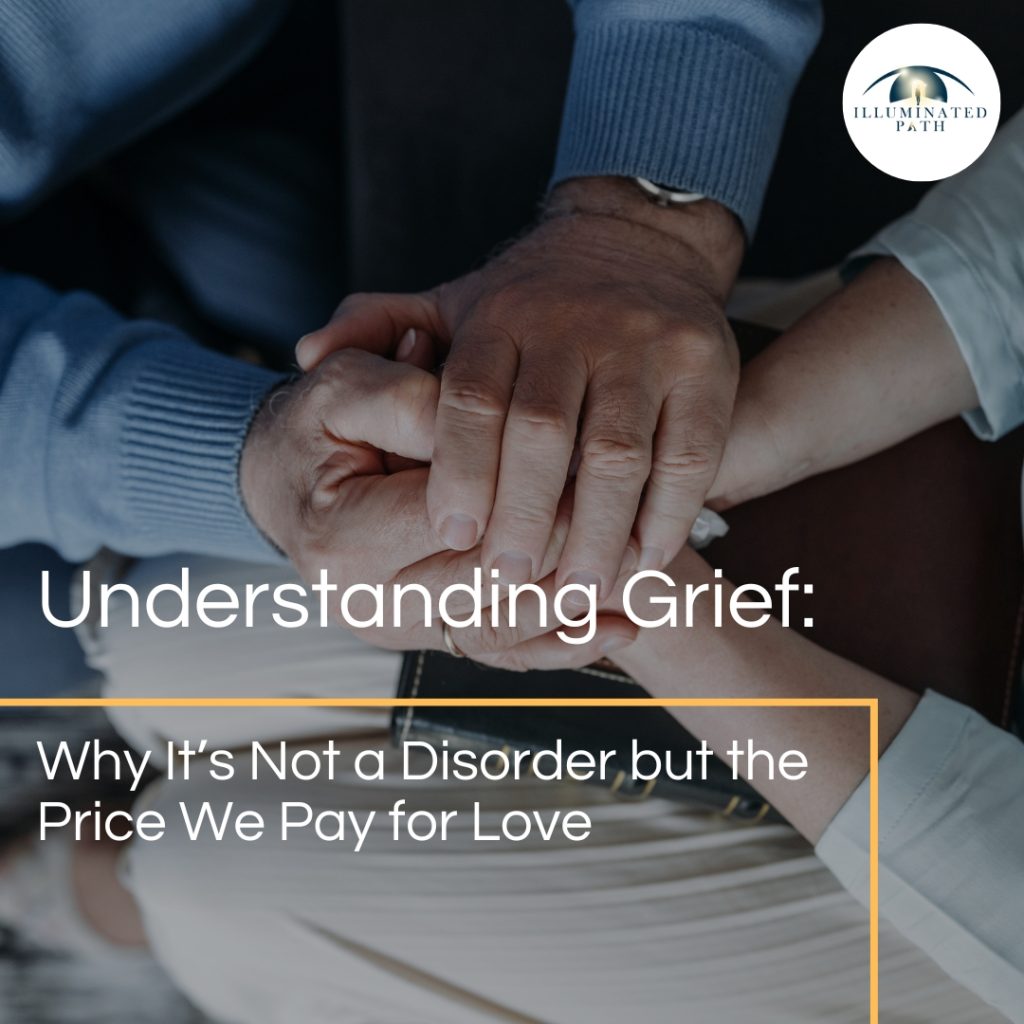
“Grief is not a disorder or a weakness. It is the price of love—a necessity that honors our emotional, physical, and spiritual bonds.” Grief is often misunderstood in our culture. It’s seen as something to hide, rush through, or fix—as if sorrow were a mistake or an illness. But grief is none of these things. Grief is not a malfunction of the human spirit. It is evidence that we dared to love deeply, that we attached, connected, and invested emotionally in someone or something that mattered profoundly. If you’re grieving right now—whether the loss is recent or decades old—this article is for you. Not to diagnose you or to offer a quick fix, but to remind you: your grief is not only valid, it is necessary. Grief Is a Reflection of Love, Not a Sign of Weakness Loss touches every life, and yet when it happens, many people feel completely alone. They wonder if they’re grieving “the right way,” if they’re being too emotional, or if there’s something wrong with them for still hurting months—or years—later. But grief doesn’t follow neat rules or a predetermined timeline. It’s not an error to be corrected or a phase to “get over.” Grief is the soul’s natural response to loss. It is as real and as human as love itself. Rather than a sign of emotional instability, grief is proof that something—or someone—was deeply meaningful. It’s what happens when love has nowhere to go. What Grief Really Is (And Isn’t) Grief extends beyond the death of a loved one. People grieve all kinds of losses: the end of a relationship, the loss of a dream, a major health diagnosis, the passing of a beloved pet, or even the loss of identity that comes with life transitions. There is no one-size-fits-all version of grief. Some feel it as intense sadness, others as numbness or anger. For some, it shows up in the body—fatigue, muscle tension, or changes in sleep and appetite. For others, it emerges more emotionally: a sense of emptiness, guilt, fear, or confusion. There’s also a common misconception that grief unfolds in tidy stages: denial, anger, bargaining, depression, and acceptance. While this model can help people understand that grief has many layers, it’s important to note that people don’t always experience these “stages” in a linear or predictable way. Grief is cyclical, not sequential. You may feel anger long after acceptance, or encounter sadness when you thought you’d moved on. What grief isn’t is pathological. It’s not a personal failure, nor does it mean you’re broken. The feelings you’re experiencing are not only understandable—they’re expected. Why “Moving On” Isn’t the Goal We live in a society that doesn’t know what to do with grief. There’s an unspoken pressure to bounce back quickly, to return to work, to be “strong.” But real grief doesn’t disappear on command, nor should it. When people tell you to “move on,” they often misunderstand what healing really means. You don’t have to move on from someone you loved. You don’t have to stop thinking about them or loving them just because time has passed. In fact, healthy grieving often includes what psychologists call “continuing bonds”—maintaining a sense of connection with the person or part of your life that has been lost, even as you begin to reengage with the present. Grief doesn’t end. It evolves. With time and care, what was once unbearable becomes something you carry with more ease. It becomes part of your story, but not the whole of it. Grief as a Sacred Process: The Physical, Emotional, and Spiritual Impact When grief hits, it affects every layer of our being: Emotionally, it can bring waves of sorrow, regret, gratitude, anger, or even moments of joy when recalling a meaningful memory. Physically, grief is exhausting. You may feel drained, experience aches and pains, or struggle with appetite and sleep. This is your body reacting to the intense stress of emotional pain. Spiritually, grief often prompts deep questioning. You may wrestle with meaning, identity, faith, or the purpose of suffering and connection. Far from being symptoms of a disorder, these reactions reflect the totality of our loss. Grief reminds us of the depth of our bonds—and how profoundly human it is to feel them. When Grief Feels Like Too Much While grief is a natural process, sometimes it can become so heavy that it feels unbearable. If you’re stuck in sadness that doesn’t shift, struggling with guilt or anger you can’t understand, or feeling like you’re losing your sense of self, these are signs that you may benefit from additional support. There’s also a form of grief known as complicated grief or prolonged grief disorder. This occurs when the natural healing process becomes stalled, and symptoms persist or intensify over time. People with complicated grief often feel unable to move forward, avoid reminders of the loss, or feel detached from life. But here’s the truth: there is no shame in needing help. Therapy isn’t just for crisis—it’s also for care. If your grief is starting to interfere with daily functioning or quality of life, a trained therapist can help you process your emotions, reduce isolation, and move toward healing at your own pace. How Grief Therapy Helps Grief therapy offers a compassionate space where your loss can be witnessed, not minimized. It allows you to: Tell your story without fear of judgment or pressure to “be okay.” Understand the complex emotions you’re experiencing. Explore unresolved feelings, such as guilt, anger, or regret. Develop coping tools that support your mental and emotional well-being. Honor your loss while slowly rebuilding your relationship with life. There is no “right” time to begin therapy. You may feel ready weeks after a loss, or not until years later. What matters most is that you’re supported in a way that feels safe and sustainable. Therapists who specialize in grief often use a variety of modalities—including talk therapy, mindfulness-based strategies, EMDR (Eye Movement Desensitization and Reprocessing), narrative therapy, and somatic practices—to meet
From Survival to Empowerment: Healing Childhood Trauma and Embracing Your Inner Strength.
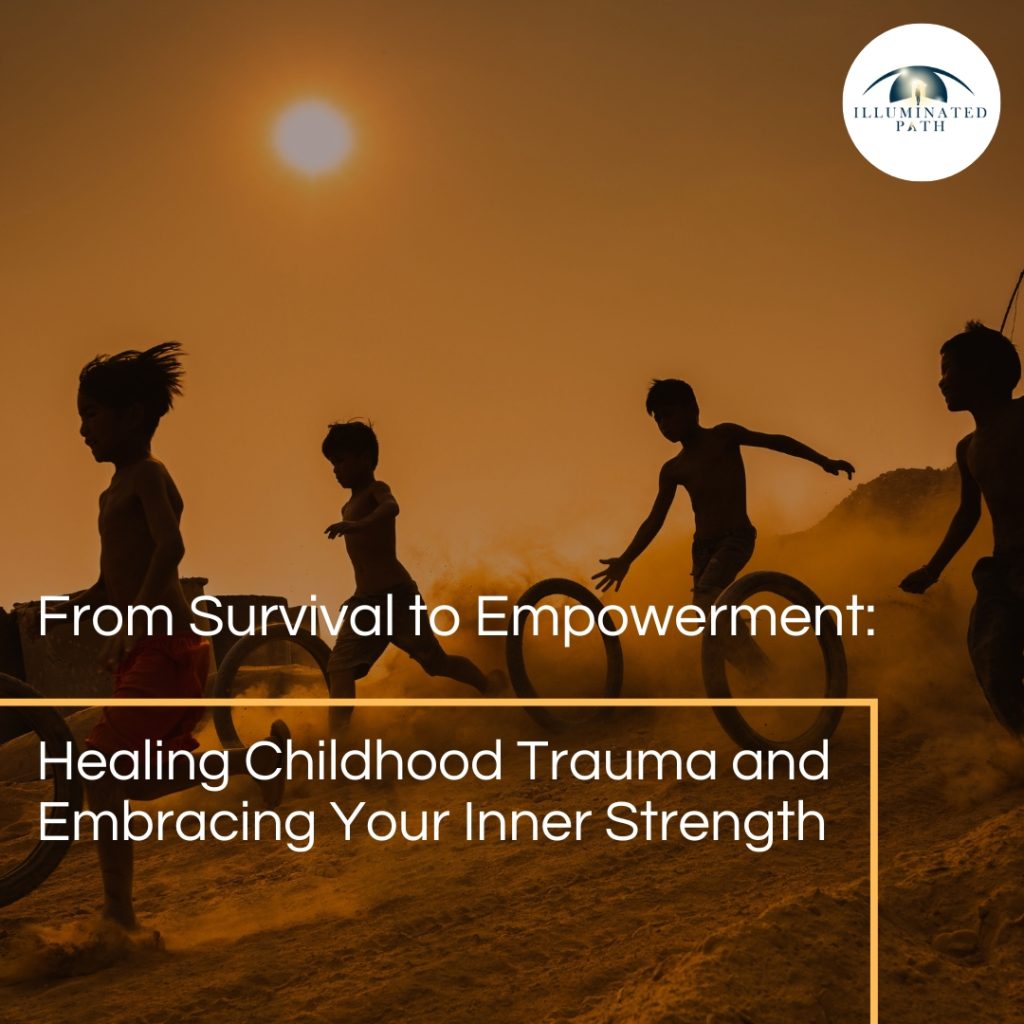
True intimacy begins where performance ends. It’s not about perfection or constant agreement. It’s about two people showing up authentically—vulnerabilities, fears, and all—without the fear of judgment. This kind of connection is rare, but it’s also the most rewarding. What Is True Intimacy? (And What It’s Not) Intimacy is often confused with physical closeness or romantic gestures. But true intimacy is emotional and psychological. It’s the deep sense of closeness that comes from mutual openness, trust, and emotional safety. True intimacy is: Being able to share your deepest thoughts and feelings without fear Feeling emotionally safe and accepted Being seen and loved for your authentic self True intimacy is not: Constant agreement or avoiding conflict Performing or pretending to be someone you’re not Relying solely on physical closeness without emotional connection As noted by Psychology Today, emotional intimacy is the glue that holds relationships together, enabling individuals to express their true selves without fear of judgment or rejection . Why Vulnerability Is the Gateway to Connection Dr. Brené Brown, a leading researcher on vulnerability, says: “Vulnerability is the birthplace of love, belonging, joy, courage, empathy, and creativity.” the outcome. It’s the willingness to say, “This is me,” even when we fear rejection. When both partners embrace vulnerability, they create a space where true intimacy can flourish. It allows for deeper understanding, empathy, and connection . The Fear of Judgment: Intimacy’s Greatest Barrier Many people avoid vulnerability because they fear judgment or rejection. This fear can prevent partners from sharing their true feelings and experiences, leading to a lack of emotional connection . Common fears include: “If I show my true self, they won’t love me.” “If I express my needs, I’ll seem needy or weak.” “If I reveal my past, they’ll judge me.” These fears can lead to emotional walls, preventing genuine connection. But hiding your true thoughts and needs erodes trust because genuine intimacy requires openness . How to Cultivate True Intimacy in Your Relationship Building true intimacy requires intentional effort and mutual commitment. Here are practical steps to deepen your connection: 1. Practice Radical Honesty Share your thoughts and feelings openly, even when it’s uncomfortable. Honesty fosters trust and allows your partner to understand your inner world. 2. Create a Judgment-Free Zone Encourage open dialogue without criticism or defensiveness. Listen actively and validate your partner’s experiences. 3. Share What Scares You Discuss your fears and insecurities. This vulnerability can lead to deeper empathy and connection. 4. Make Space for Each Other’s Inner World Be curious about your partner’s thoughts and feelings. Ask open-ended questions and show genuine interest. 5. Build Trust Through Consistency and Care Follow through on promises and be reliable. Consistent actions build a foundation of trust. By prioritizing emotional intimacy, you create a solid foundation for a fulfilling and lasting partnership . The Payoff: Why True Intimacy Is Worth the Risk Embracing vulnerability and cultivating true intimacy can lead to: Greater Relationship Satisfaction: Couples who share openly experience deeper connection and fulfillment. Enhanced Emotional Resilience: Facing challenges together strengthens the bond and builds resilience. Increased Trust and Security: Consistent honesty and openness foster a safe and trusting environment. Emotional intimacy is the glue that holds relationships together, enabling individuals to express their true selves without fear of judgment or rejection . Final Thoughts: Choose Vulnerability Over Performance True intimacy requires courage—the courage to be seen, to be vulnerable, and to risk rejection. But the reward is profound: a deep, authentic connection where both partners feel valued, understood, and loved. Reflect on your relationships: Are you showing up authentically? Are you creating a safe space for your partner to do the same? Embrace vulnerability. Let go of the fear of judgment. And experience the transformative power of true intimacy. The Author Dr. Shadi Souferian Psy. D. Licensed Clinical Psychologist Therapist And Psychologist in Los Angeles And Beverly Hills. You might also enjoy this article: Understanding Grief: Why It’s Not a Disorder but the Price We Pay for Love April 28, 2025Life Transformation “Grief is not a disorder or a weakness. It is the price of love—a necessity…Read more From Survival to Empowerment: Healing Childhood Trauma and Embracing Your Inner Strength. April 22, 2025Life TransformationPersonal Development True intimacy begins where performance ends. It’s not about perfection or constant agreement. It’s about…Read more True Intimacy: The Power of Being Fully Seen Without Fear of Judgment. April 19, 2025Relationship True intimacy begins where performance ends. It’s not about perfection or constant agreement. It’s about…Read more How Resilience Helps Us Overcome Stress: Adapt, Don’t Avoid April 15, 2025Personal Development Introduction: Why Resilience Matters Now More Than Ever Whether it’s the pressure of deadlines, a…Read more Beyond Words: Why True Empathic Listening is the Cornerstone of a Powerful Relationship March 26, 2025Relationship In the intricate dance of human connection, particularly within the intimate sphere of a romantic…Read more When the Smoke Detector Never Stops Beeping: Understanding and Addressing Chronic Anxiety March 18, 2025Personal DevelopmentTrauma Daniel Goleman, the renowned expert on emotional intelligence, offered a potent analogy for understanding anxiety:…Read more
Lost Homes, Lost Hope? Navigating Grief and Loss After the LA Fires
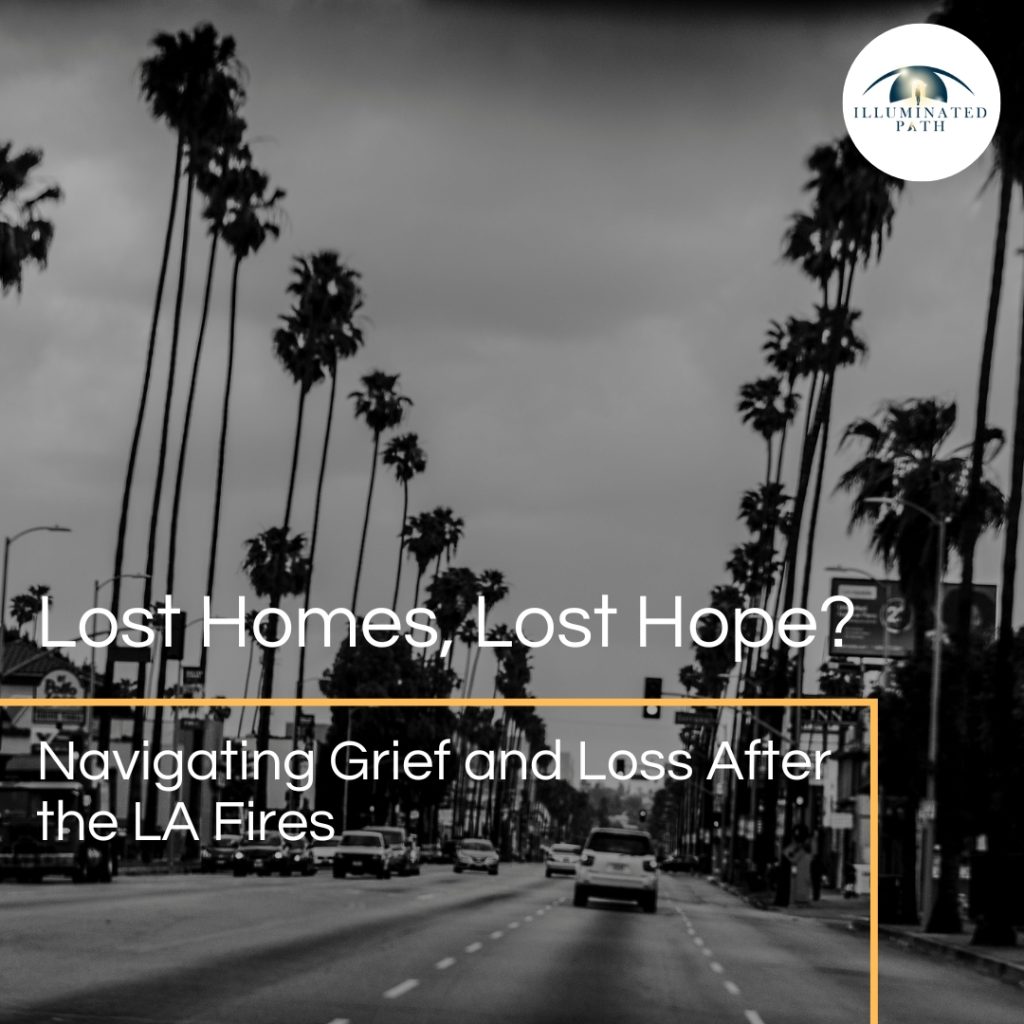
The acrid smell of smoke, the orange glow against the night sky, the frantic scramble for safety – these are the searing memories etched into the minds of those who have lived through the devastating wildfires that have ravaged Los Angeles in recent years. While the physical scars on the landscape may eventually heal, the emotional wounds of loss run deep, leaving individuals and communities grappling with grief, displacement, and a profound sense of disorientation. Losing one’s home to a wildfire is a uniquely traumatic experience. It’s not just the loss of a physical structure; it’s the loss of a sanctuary, a repository of memories, a symbol of stability and security. It’s the loss of a sense of place, of belonging, of identity. Navigating this complex grief requires understanding, compassion, and a multifaceted approach to healing and recovery. The Magnitude of Loss: Statistics Paint a Grim Picture The statistics on wildfire-related losses in Los Angeles paint a stark picture of the devastation faced by individuals and communities. The Woolsey Fire in 2018 burned nearly 97,000 acres, destroyed over 1,600 structures, and resulted in three fatalities. (Source: CAL FIRE) The Getty Fire in 2019 burned over 745 acres, destroying 12 homes and damaging five others. (Source: LAFD) And the Bobcat Fire in 2020 burned over 115,796 acres, destroying 171 structures and damaging 47 others. (Source: Angeles National Forest) These numbers represent not just property damage, but the shattering of lives, the disruption of communities, and the profound emotional toll of losing one’s home and sense of place. The Complexities of Grief After Wildfire Grief after a wildfire is a complex and multifaceted experience. It’s not just the loss of the physical home; it’s the loss of cherished memories and belongings. Homes hold a lifetime of memories, from childhood photos to treasured heirlooms. These tangible reminders of the past are often irreplaceable, leaving a void that can be difficult to fill. Losing a home also shatters one’s sense of security and stability. Home represents a safe haven, a place of comfort. This loss can trigger feelings of vulnerability, anxiety, and fear. Furthermore, wildfires can disrupt the social fabric of neighborhoods and communities, which provide a sense of belonging and support. This can leave individuals feeling isolated and alone. Our homes are often intertwined with our sense of self and our connection to a particular place. Losing this connection can lead to feelings of disorientation and a loss of identity. For many, their home represents their dreams and aspirations for the future. Losing this symbol of hope can be particularly devastating. The Stages of Grief: A Roadmap, Not a Straight Line While grief is a unique and personal experience, it often follows a general pattern of stages, as outlined by Elisabeth Kübler-Ross in her seminal work “On Death and Dying.” These stages include denial, anger, bargaining, depression, and acceptance. It’s important to remember that these stages are not linear, and individuals may experience them in different orders or revisit stages multiple times. Grief is a journey, not a destination, and there is no right or wrong way to grieve. Navigating the Challenges: Coping with Grief and Loss Coping with the grief and loss after a wildfire requires a multifaceted approach that addresses the emotional, psychological, and practical challenges. Emotionally and psychologically, it’s crucial to acknowledge and validate the full range of emotions without judgment. Seeking professional help through therapy can provide a safe space to process these emotions and develop coping skills. Connecting with others, whether it’s friends, family, or support groups, can offer a sense of connection and validation during this difficult time. Practicing self-care through activities like mindfulness, exercise, and spending time in nature can also help reduce stress and foster resilience. On a practical level, it’s important to access community resources. Connect with local organizations and government agencies that offer assistance with housing, financial aid, and other needs. Engaging in the process of rebuilding your home and community can provide a sense of purpose and hope. Creating new rituals and traditions can help honor memories and establish a sense of continuity with the past. While acknowledging the pain of the past, it’s essential to focus on creating a new future filled with hope and possibility. Rebuilding Hope: Finding Meaning and Purpose After Loss While the loss of a home can be devastating, it can also be an opportunity for growth, transformation, and the discovery of new meaning and purpose. Research suggests that individuals can experience positive psychological changes after trauma, such as increased resilience, greater appreciation for life, and stronger relationships. This is known as post-traumatic growth. The experience of loss can prompt individuals to re-evaluate their priorities, discover new passions, and find new ways to contribute to their communities. Wildfires can also bring communities together, fostering a sense of shared purpose and collective resilience. The Role of Community: Healing Together Healing from wildfire trauma is not just an individual journey; it’s a collective effort. Communities play a vital role in supporting individuals and families through grief and loss by fostering a culture of empathy and understanding. This can help individuals feel safe and supported as they navigate their grief. Providing resources and services, such as access to mental health services, financial assistance, and practical support, can be instrumental in helping individuals and families rebuild their lives. Creating opportunities for community gatherings, events, and activities can help to rebuild social connections and foster a sense of belonging. Sharing stories of resilience, celebrating community strengths, and focusing on the future can inspire hope and empower individuals to move forward. Conclusion: From Loss to Renewal Losing a home to a wildfire is a profound loss, but it does not have to extinguish hope. By acknowledging the complexities of grief, accessing support, and embracing a community-oriented approach to healing, individuals and communities can navigate the challenges, rebuild their lives, and find new meaning and purpose in the aftermath of the flames. The journey from loss
Finding the Way Back to Connection: How Therapy Fosters Deeper Relationships With Self and Others
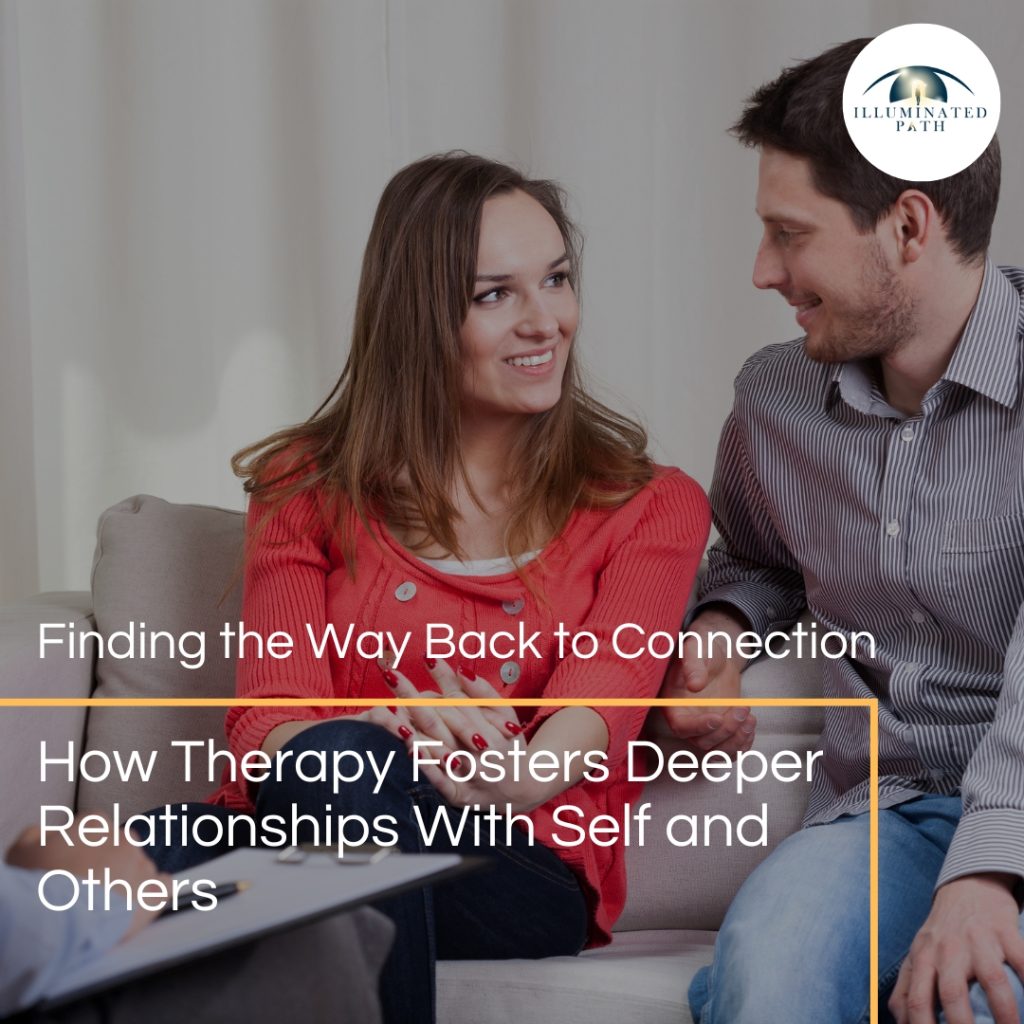
“In therapy, we are trying to help people feel more connected to themselves and others.” – Sue Johnson This insightful quote from Dr. Sue Johnson, a renowned clinical psychologist and developer of Emotionally Focused Therapy (EFT), perfectly captures a fundamental truth about the human experience: we are wired for connection. Our brains are intricately designed to seek out and thrive in relationships, and when these connections are fractured or absent, we suffer deeply. Therapy, in its many forms, offers a pathway back to this essential connection. It provides a safe and supportive space to explore the barriers that prevent us from experiencing genuine intimacy with ourselves and others, and to develop the skills necessary to build and maintain healthy relationships. The Science of Connection The need for connection is not merely a social construct; it is deeply rooted in our biology. Research in neuroscience and attachment theory has revealed the profound impact that relationships have on our physical and mental well-being. Attachment theory, pioneered by John Bowlby and Mary Ainsworth, proposes that our early childhood experiences with caregivers shape our internal working models of relationships, influencing how we connect with others throughout our lives. Secure attachment, characterized by feelings of safety and trust, fosters emotional regulation, resilience, and healthy relationships. In contrast, insecure attachment, often stemming from early experiences of neglect or trauma, can lead to difficulties with intimacy, trust, and emotional regulation. (Source: Bowlby, J. (1969). Attachment and Loss, Vol. 1: Attachment.) Furthermore, advances in neuroscience have illuminated the neural mechanisms underlying connection. The discovery of mirror neurons, which fire both when we perform an action and when we observe someone else performing the same action, suggests that our brains are wired for empathy and understanding others. Moreover, the release of oxytocin, often referred to as the “love hormone,” during social interactions promotes feelings of trust, bonding, and well-being. (Source: Rizzolatti, G., & Craighero, L. (2004). The mirror-neuron system. Annual Review of Neuroscience, 27, 169-192.) Social psychology research consistently demonstrates the detrimental effects of social isolation and loneliness on mental and physical health. Loneliness has been linked to an increased risk of depression, anxiety, cardiovascular disease, and even premature death. Conversely, strong social connections are associated with greater happiness, resilience, and longevity. (Source: Holt-Lunstad, J., Smith, T. B., & Layton, J. B. (2010). Social relationships and mortality risk: A meta-analytic review. PLoS Medicine, 7(7), e1000316.) Disconnection: The Root of Suffering When our need for connection is unmet, or when our relationships are characterized by conflict, insecurity, or trauma, we experience a profound sense of disconnection. This disconnection can manifest in various ways, such as disconnection from self, disconnection from others, and disconnection from the world. Trauma, neglect, or societal pressures can lead to a disowning of parts of ourselves. We may disconnect from our emotions, needs, or authentic selves in an attempt to protect ourselves from pain or rejection. This can lead to feelings of emptiness, shame, and a lack of purpose. Insecure attachment, past hurts, or communication difficulties can create barriers to intimacy and connection with others. We may struggle with trust, vulnerability, or expressing our needs, leading to isolation, conflict, and unsatisfying relationships. A sense of disconnection can also extend to a feeling of alienation from the world around us. We may feel lost, hopeless, or unable to find meaning or purpose in life. This disconnection lies at the root of much human suffering, fueling depression, anxiety, addiction, and a host of other mental and physical health problems. Therapy as a Path to Reconnection Therapy, in its various forms, offers a powerful antidote to disconnection. It provides a safe and supportive space to explore and heal past wounds, develop self-awareness, improve communication skills, build trust and intimacy, cultivate self-compassion, and find meaning and purpose. Therapy can help individuals process past traumas, explore the roots of insecure attachment, and address unresolved emotional pain that may be hindering their ability to connect. It fosters greater awareness of one’s thoughts, feelings, needs, and behaviors. This increased self-understanding allows individuals to connect with their authentic selves and make choices that are aligned with their values. Therapy can also help individuals develop effective communication skills, including active listening, assertiveness, and expressing emotions in a healthy way. These skills are essential for building and maintaining healthy relationships. By identifying and overcoming barriers to trust and intimacy, such as fear of vulnerability or past betrayals, therapy can help individuals build deeper connections with others. Moreover, therapy encourages self-compassion, which involves treating oneself with kindness, understanding, and acceptance. This allows individuals to heal from past hurts and develop a more positive and loving relationship with themselves. Finally, therapy can help individuals explore their values, passions, and goals, and to find meaning and purpose in their lives. This sense of purpose can foster a deeper connection to oneself and the world around them. Different Therapeutic Approaches to Fostering Connection Different therapeutic approaches offer unique perspectives and techniques for fostering connection. Some of the most common include Emotionally Focused Therapy (EFT), Cognitive Behavioral Therapy (CBT), Psychodynamic Therapy, Mindfulness-Based Therapies, and Somatic Experiencing. EFT, developed by Sue Johnson, focuses on the emotional bond between partners and helps them to identify and change negative interaction patterns that contribute to disconnection. It emphasizes the importance of emotional responsiveness and accessibility in creating secure attachment. (Source: Johnson, S. M. (2004). The practice of emotionally focused couple therapy: Creating connection. Routledge.) CBT helps individuals identify and challenge negative thought patterns and behaviors that contribute to depression, anxiety, and relationship problems. It focuses on developing coping skills and changing unhelpful behaviors to improve emotional regulation and interpersonal effectiveness. (Source: Beck, A. T. (1976). Cognitive therapy and the emotional disorders. International Universities Press.) Psychodynamic therapy explores the unconscious processes that influence thoughts, feelings, and behaviors. It often focuses on early childhood experiences and relationships to understand current patterns of relating. (Source: Gabbard, G. O. (2014). Psychodynamic psychiatry in clinical practice. American
The Symphony of Stress: Understanding and Navigating the Body’s Alarm System
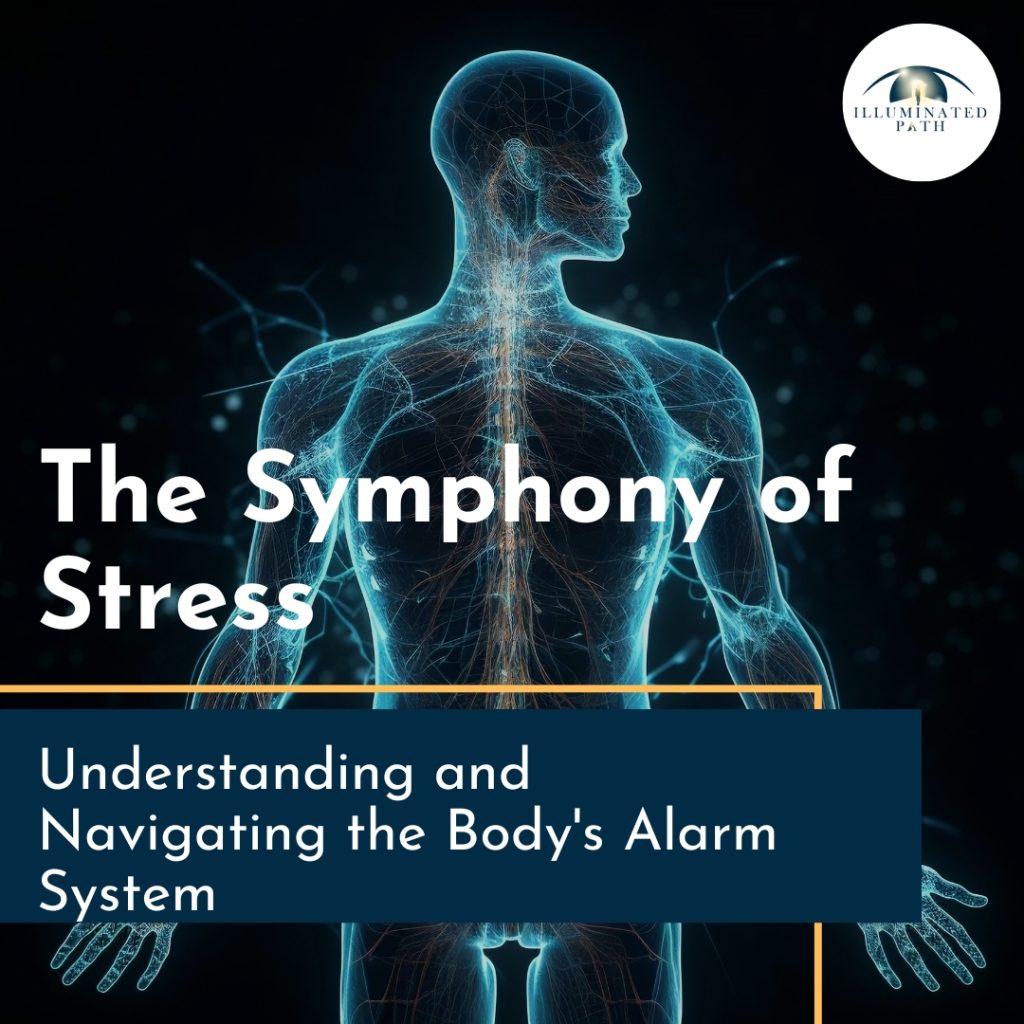
Stress. The word itself can evoke a visceral reaction, conjuring images of deadlines, overflowing inboxes, and a never-ending to-do list. In today’s fast-paced world, stress has become an unwelcome companion for many, casting a shadow over our well-being and hindering our ability to thrive. But what if we could change our relationship with stress, transforming it from a relentless adversary into a valuable guide? This article delves into the intricate world of stress, exploring its physiological and psychological underpinnings, its impact on our health, and most importantly, how we can navigate its complexities to lead more balanced and fulfilling lives. The Biology of Stress: A Symphony of Hormones and Neurotransmitters To truly understand stress, we must first explore its biological roots. At its core, stress is a survival mechanism, an intricate symphony of hormones and neurotransmitters orchestrated to protect us from perceived threats. When confronted with a challenging situation, our brain triggers the release of adrenaline and cortisol, hormones that prepare our body for action. Heart rate accelerates, breathing quickens, muscles tense, and senses sharpen – all in an effort to mobilize our resources for a fight-or-flight response. While this response can be life-saving in acute situations, chronic stress, where this alarm system remains activated for prolonged periods, can have detrimental effects on our health. Elevated cortisol levels can disrupt sleep, impair immune function, increase inflammation, and contribute to a range of chronic diseases, including cardiovascular disease, diabetes, and depression. The Pervasiveness of Stress: A Global Concern The impact of stress is widespread, affecting individuals across all walks of life. According to the World Health Organization, stress is a significant contributor to the global burden of disease, with mental health disorders, including those related to stress, accounting for 13% of the total global burden. In the United States, the American Psychological Association’s (APA) 2023 Stress in America™ survey revealed alarming statistics: Inflation: 83% of adults cite inflation as a significant source of stress. Work: 79% of adults report work-related stress. The future of our nation: 76% feel stressed about the future of the nation. Money: 76% experience stress related to money. Violence and crime: 75% are stressed about violence and crime. These figures underscore the urgent need for effective stress management strategies to mitigate the impact of stress on individuals and society as a whole. Beyond Fight-or-Flight: The Diverse Faces of Stress While the fight-or-flight response is a well-known aspect of stress, it’s crucial to recognize that stress manifests in diverse ways, depending on individual factors, the nature of the stressor, and the context in which it occurs. Acute Stress: This is the short-term stress we experience in response to immediate challenges, such as a presentation, a traffic jam, or an argument. While it can be uncomfortable, acute stress is typically manageable and resolves once the situation has passed. Episodic Acute Stress: Individuals who frequently experience acute stress, often due to a fast-paced lifestyle or a tendency to overcommit, may suffer from episodic acute stress. This can lead to persistent feelings of overwhelm, irritability, and tension. Chronic Stress: This is the long-term stress that persists over weeks, months, or even years. It can stem from ongoing challenges like financial difficulties, relationship problems, job dissatisfaction, or chronic illness. Chronic stress can take a significant toll on our physical and mental health, increasing the risk of various health problems. According to the American Institute of Stress, job stress alone is estimated to cost U.S. businesses over $300 billion annually in absenteeism, turnover, diminished productivity, and medical, legal, and insurance costs. The Mind-Body Connection: How Stress Impacts Our Health The intricate connection between our mind and body means that stress doesn’t just affect our emotions; it can manifest in a myriad of physical symptoms. These can include: Musculoskeletal System: Muscle tension, headaches, back pain, and jaw clenching. The National Institute of Neurological Disorders and Stroke estimates that tension headaches affect up to 80% of adults. Cardiovascular System: Increased heart rate, palpitations, high blood pressure. Chronic stress is a significant risk factor for cardiovascular disease, the leading cause of death worldwide, according to the World Health Organization. Respiratory System: Rapid breathing, shortness of breath. Stress can exacerbate respiratory conditions like asthma and chronic obstructive pulmonary disease (COPD). Gastrointestinal System: Stomach upset, nausea, diarrhea, constipation. The American Psychological Association reports that stress can contribute to irritable bowel syndrome (IBS) and other digestive disorders. Immune System: Weakened immune response, increased susceptibility to infections. Studies have shown that chronic stress can suppress immune function, making individuals more vulnerable to illness. Nervous System: Anxiety, irritability, difficulty concentrating, sleep disturbances. The National Institute of Mental Health estimates that anxiety disorders affect over 40 million adults in the United States. Recognizing these physical manifestations of stress is crucial, as they can serve as valuable signals that something needs to change in our lives. Decoding the Stress Signals: A Personalized Approach While stress can manifest in various ways, the specific symptoms we experience are often unique and provide valuable clues about the underlying causes of our stress. By paying attention to these signals, we can gain insights into the areas of our lives that require attention. Physical Sensations: Are you experiencing muscle tension, headaches, digestive issues, or sleep disturbances? These can indicate a need for better self-care, such as incorporating regular exercise, relaxation techniques like progressive muscle relaxation or meditation, and prioritizing sleep hygiene. For example, if you’re constantly experiencing tension headaches, it might be a sign that you need to incorporate relaxation techniques like progressive muscle relaxation or meditation into your daily routine. Emotions: Are you feeling overwhelmed, anxious, irritable, or sad? These emotions might signal a need to address underlying emotional issues, set boundaries in your relationships or at work, or seek support from loved ones or a therapist. Feeling overwhelmed might indicate that you need to re-evaluate your workload and learn to say “no” to additional commitments. Thoughts: Are you engaging in negative self-talk, catastrophizing, or ruminating on worries? These thought patterns can contribute to
Finding Meaning in Life’s Transformations: Embracing Change with the Help of Psychology
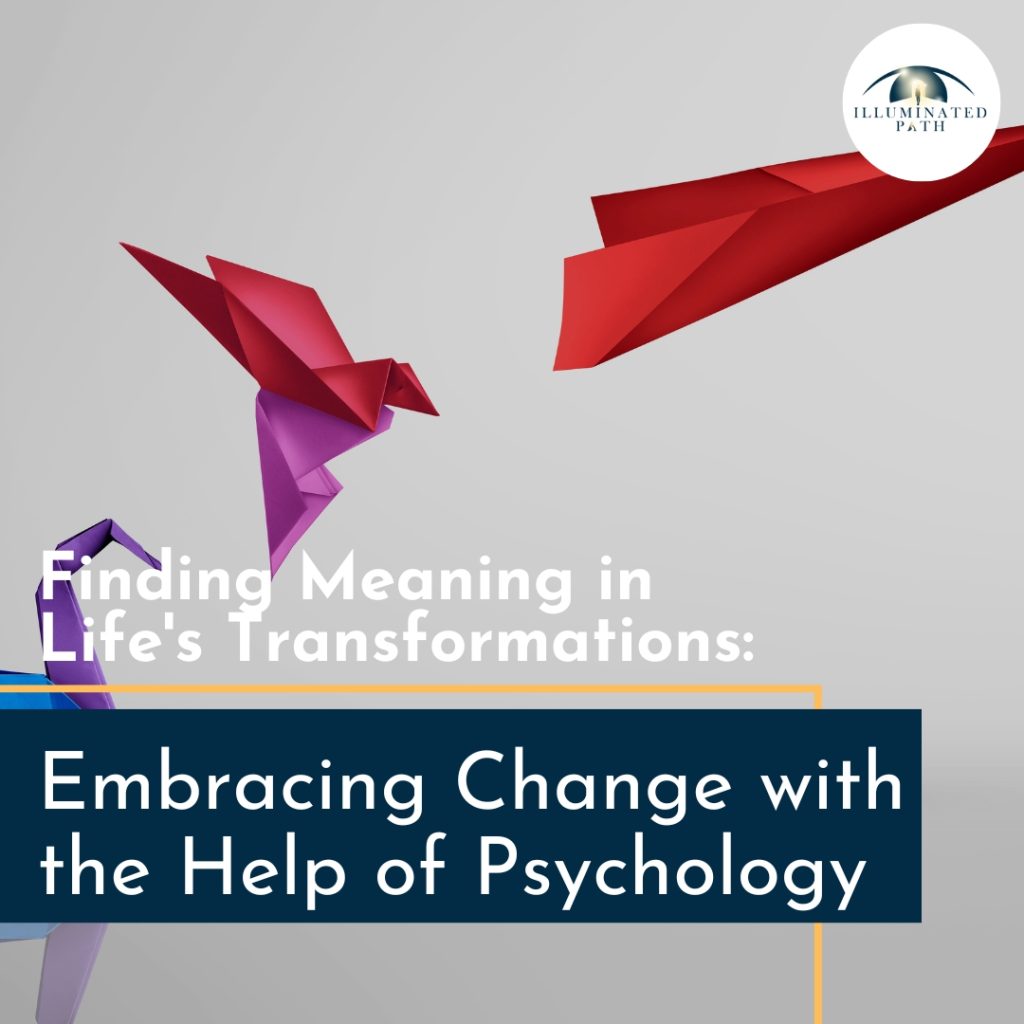
Life is a symphony composed with notes of joy, sorrow, triumph, and challenge. It’s a continuous dance of transformations, where each step, whether planned or unexpected, shapes the narrative of our existence. While some changes bring exhilarating new beginnings, others may leave us feeling lost, adrift in a sea of uncertainty. In these moments of transition, the support of a psychologist can be an invaluable compass, guiding us towards meaning, purpose, and renewed strength. The Prevalence of Life Transitions and their Impact Life transitions are an inevitable part of the human experience. Research suggests that major life events, both positive and negative, can significantly impact our mental and emotional well-being. According to a study published in the Journal of Personality and Social Psychology, individuals experiencing significant life events are more likely to report symptoms of depression and anxiety. Furthermore, the American Psychological Association highlights that stress related to major life changes is a common concern for many individuals. Whether it’s starting a new job, moving to a new city, experiencing a relationship change, or coping with the loss of a loved one, these transitions can trigger a range of emotional responses and challenges. The Power of Psychological Support Psychological services offer a safe haven where individuals can explore the complexities of their experiences, emotions, and thoughts. In the context of life’s transformations, a psychologist can help you: Understand and process your emotions: Change often triggers a cascade of emotions, from excitement and anticipation to grief, anxiety, or anger. A psychologist provides a non-judgmental space to unravel these feelings, fostering self-awareness and emotional regulation. Studies have shown that therapy can be effective in reducing symptoms of depression and anxiety associated with life transitions. Develop healthy coping mechanisms: Whether you’re facing a career change, a relationship shift, or a personal loss, a psychologist can equip you with effective coping skills to navigate the challenges and stressors that arise. These tools empower you to manage difficult emotions, build resilience, and maintain your overall well-being. Research indicates that individuals who engage in therapy develop improved coping skills and experience reduced stress levels. Find meaning and purpose in the midst of change: Transitions can sometimes shake our sense of identity and purpose. A psychologist can help you explore the deeper significance of your experiences, identify your values, and discover new paths that align with your evolving self. Studies suggest that therapy can facilitate the process of meaning-making, leading to greater life satisfaction and well-being. Cultivate resilience: Life’s journey is rarely smooth sailing. A psychologist can help you develop the inner strength and adaptability needed to weather life’s storms, bounce back from setbacks, and emerge stronger on the other side. Research has shown that therapy can enhance resilience, enabling individuals to cope more effectively with future challenges. Embrace change as an opportunity for growth: While change can be daunting, it also presents opportunities for personal development and transformation. A psychologist can guide you in reframing challenges as stepping stones, fostering a mindset that embraces change as a catalyst for growth. Studies indicate that therapy can promote post-traumatic growth, where individuals experience positive psychological changes following adversity. Seeking Support : A Sign of Strength It’s important to remember that seeking psychological support is not a sign of weakness, but rather a testament to your courage and commitment to your well-being. Just as we consult a doctor for physical ailments, seeking the guidance of a mental health professional is an essential step in nurturing our emotional and psychological health. If you’re navigating a life transition, big or small, consider reaching out to a psychologist. They can provide the tools, insights, and support you need to find meaning, purpose, and resilience in the face of change. Remember, you don’t have to walk this path alone. With the help of a psychologist, you can embrace life’s transformations and emerge stronger, wiser, and more empowered than ever before. The Author Dr. Shadi Souferian Psy. D. Licensed Clinical Psychologist Therapist And Psychologist in Los Angeles And Beverly Hills. You might also enjoy this article: Finding Meaning in Life’s Transformations: Embracing Change with the Help of Psychology September 25, 2024By:drsvahediLife TransformationLifetransition0Comments Life is a symphony composed with notes of joy, sorrow, triumph, and challenge. It’s a…Read more Anxiety and Relationships: Communication and Understanding – The Statistical Picture September 19, 2024By:drsvahediRelationship0Comments Anxiety disorders, with their pervasive reach, impact a significant portion of the population, casting a…Read more How Couples Therapy Can Strengthen Your Bond: A Path to Lasting Love September 18, 2024By:drsvahediRelationship0Comments Maintaining a fulfilling and harmonious relationship requires ongoing effort and dedication. Even the most devoted…Read more How to Stop the Cycle of Fighting in a Relationship July 31, 2023By:drsvahediRelationshipConflict ResolutionCoupleHealthy Relationships0Comments Fighting is a natural part of any relationship, but when it becomes a recurring pattern,…Read more Unlocking Inner Harmony: Discover the Power of Internal Family Systems (IFS) Therapy June 15, 2023By:drsvahediUncategorized0Comments Discover the Power of Internal Family Systems (IFS) Therapy In the depths of our beings…Read more Healing Trauma: A Deep Dive into the Effectiveness of EMDR Therapy for PTSD May 2, 2023By:drsvahediUncategorized0Comments Healing Trauma: A Deep Dive into the Effectiveness of EMDR Therapy for PTSD When it…Read more
